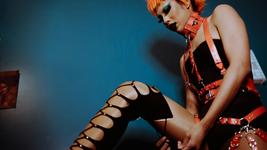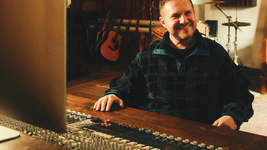Stitching For Spotlights - An Interview With Tristan Raines: On The 'Fangtastic' Looks of Dracula A Comedy Of Terrors
- Khadeejah Masud
- Mar 30
- 9 min read
Updated: Mar 31

Welcome to the first article in my ongoing series Stitching for Spotlights, where we discuss all things theatre and fashion. For a self-proclaimed ‘theatre-kid’, for me there is nothing that combines both so well as the phenomenon of a Broadway hit. Dracula: A Comedy of Terrors, a story that sees lead Jonathan Harker held captive by an oh-so-modern Dracula, is no exception.

I was thrilled to snag tickets for the opening night of this riotous and fast-paced adaptation of Bram Stoker’s gothic – directed by Gordon Greenberg, the comedy delivers a twist on the narrative charged with innuendos, theatrical absurdity, and a generous dose of camp, fit to satisfy its 21st century audience. Beyond its sharp humour, gorgeous cast and rapid-pace performance, the costumes really brought this narrative to life. The marriage of The Gothic to Gen-Z’s quirks especially resonated with me - you could say it sunk its teeth right into my conscience.
At the heart of this genius is designer Tristan Raines, whose designs artfully fuse the classic – Victorian drama – with the modern, in sweeps of passionate magenta, skimpy black lace and the most dramatic cape to grace a London stage since Phantom. I had the pleasure of speaking with Tristan about his inspirations, hidden design details and the symbolic magic that keeps the audience captivated by Dracula’s enchantment. Here’s an intimate look at how fashion got its fangs in this bold new take on Dracula.
Designing The OG Diva
We started by discussing Count Dracula’s origins – traditionally, we find him situated in the epitome of gothic drama - broody, dark, and seductively eerie - but in Dracula: A Comedy of Terrors, he also had to be playful. I was curious to know how the design approach would vary, to transform him into this goofball player of a vampire, brought to life by James Daly.
Tristan, like any great designer, used the character’s legacy as a starting point, before “trying to find the humour” behind this new take. “To truly understand how society would see Dracula in a comedic story, we have to understand how society sees him iconically in the present,” he explains. The challenge lay in how they could balance the iconic with the eccentric. “Dracula is actually the ‘straight character’ of the show” – a sort of anchor in our perception as the audience, with most of the chaos unfolding from the characters around him. An interesting takeaway of this conversation was how intertwined design is across all departments - this idea of Drac as the “constant” manifested visually through set design, which subtly mirrors him in deep blues to foreground his presence. As for the costume itself? Both classic vampire tropes appear in his costumes, as well as those that are not-so traditional and have more of a 21st century twist to revive the character within the audience’s contemporary imagination. This comes from the iconism of his character, which took Raines through a rabbit hole of research in watching several films and TV shows like Dracula: Dead And Loving It, The Little Vampire, Blubberella, Dark Shadows, Reinfield, The Munsters, and What Do We Do In The Shadows, to provide a glimpse into what we now see onstage.
Two pieces in the Count’s wardrobe – both anything but complimentary, stood out the most when I went to see the show. That first being his trademark – “The look that always stayed”, that Raines describes was always intended to be “super queer and dramatic” – the lace crop top and leather ensemble, followed by his swooping blue overcoat paired with a cape that transports us right to the heart of Victorian society. “Dracula always has lace on him historically, so we took that idea and made a lace crop top. Then we added an athletic edge—thin cut-up, muscle-revealing silhouettes—to bring in this fresh, queer-coded energy.” The result? A Dracula that’s as dramatic as ever, but with a spicy and contemporary flair that makes him feel right at home in 2024.
The blue overcoat look on the other hand is more about grounding the historic in the present moment - branding him as uniquely ‘Dracula’ against the more popular depictions like that of Gary Oldman’s version in 1992, drawing inspiration directly from the Victorian fashion period and the storyline itself. Raines explains that, “We knew we wanted a ‘Sexy Fabio’ moment with just the white shirt. The blue floral felt Victorian masculine and the flowers hark back to his interest in earth and that we are all part of the earth even in death. There is also connective tissue to his flower moment with Lucy [...] I owe everything for this look to a fantastic designer named Louise Bourret.” Thanks Louise! What I would give to own that coat (bonus points if Dracula is in it).
Costume Comedics & Theatrical Presence

Another key aspect of costume in this production are the pantomime-esque outfits of Mina and Van Helsing, characters who animate the play and are portrayed by the same actor (in the London production, Sebastien Torkia brings them to life with his spunky performance). Illuminated by our conversation, the blend of historic reference and campy irreverence breathes life into the show’s visual language.

Raines has been kind enough to provide us with some of his original sketches, and accompanies them with the description, “we wanted to always see the actors' own gender in the looks...it's a bolero jacket and skirt, but we see the ‘Prologue’ male vest under it with suspenders. So it wasn't ‘making fun of gender’ it's more Shakespearean or even classic queer theatre from NYC in the 1990s. This gender bending and the comedic play on gender is very much in the historical context of our show.”

Van Helsing’s looks throughout epitomises the bold fusion of period accuracy and heightened absurdity. He touched on how much of an engineering marvel this look is in all its glory; “this costume is made by a maker who got started with opera costumes, making it a heavy tank of a dress [...] When it arrived here, the wardrobe team was astonished by its construction. It's quite magical.”

The silhouette is inspired by traditional German national dress, but adopts a unique twist: “We wanted to add a bit of ‘Trunchbull’ energy,” Raines explains, “which started with the dress colour, the exaggerated shoulders, and the hair buns - eventually turning into two, with a pretzel braid.” As if that weren’t enough of a theatrical wink, the team even custom-printed pretzel fabric, subtly woven into the piping and apron, making it a hidden visual gag for those who look closely. This costume was a later addition to the production, debuting at The Old Globe, replacing an earlier Victorian hunting outfit that, as Raines puts it, “didn’t quite land.” The new design, with its full blouse and puff sleeves (hidden beneath the dress, much to Raines’ dismay - “the sleeves have this incredible crochet lace detail on the cuffs”), gives the actor more room for physical comedy, reinforcing the over-the-top theatricality characterising this show.
I’d be remiss if I didn’t also discuss the looks that make Lucy, played by the wonderful Safeena Ladha. These sweeping feminine outfits that graced the stage instantly caught my eye, revealing that beneath the surface of her intelligence and propriety there is an unruly passion in the likes also found in Dracula. Her wardrobe is entirely composed of these magentas and purples, which coincide with the way the play was marketed against a purple background. I thought this really emphasised her role in the story. When I brought this up with Raines, he stated that deeper than this take is a “very personal designer reason for this palette” - a simple love for his leading ladies being dressed in this warm and rich tone. He relays, “I'm a true lover of all things brocade as well. It's my first stop on any swatching experience. With these fabrics, I wanted something that had a floral and femme pattern and textures (as you will see throughout the whole show). As a designer, my entire process is based on texture. I believe in high texture everywhere with small spaces for neutrals for the eye to rest, and this look is that for sure. The magenta brocade texture is inspired by veins. It has a vein pattern, so this also became really important” - tying the audience back to Dracula’s bloodthirsty nature. He talks about how they wanted to create a “hybrid Victorian period, fusing an ethos of "gothic victorian" that the audience typically associates it with due to pop culture tropes.
In the show, Lucy’s passions for…well, the passionate, are shown through these conservative looks becoming freer whether that is through colour, layering or fabrics. An outfit that was iconised in a viral clip on Instagram is her nightgown look that Raines says was “always in the show from the beginning”. He continues, “It's actually based off of the robe in Phantom of the Opera but an all lace version. So a little nod to something else British and yet another connection to the ethos of scary or horror! I wanted something that felt dramatic and classic horror. It needed to have an old Hollywood dramatic horror effect as well, which is why it's rigged to come open in a very special way so Lucy can do her dramatic breathing on the wall” - a moment many viewers fell in love with, costumes playing a fundamental part in that experience!
Challenges, Clever Costume Hacks & Collaboration

With a five-person cast, it goes without saying that quick changes were necessary for actors to inhabit multiple roles and shift easily between scenes and the technicality of each item is important. Raines emphasised this, “the costumes actually have a lot of tricks built into them that the audience doesn't know. For instance the Reinfeld straight jacket (which is our take on him taking a straight jacket and making it into livery. So he paints stripes and puts on a bowtie...little detail I don't think people realise)...but that jacket actually closes in several different ways in order to be able to do the track. It has a main zipper as the closure, but also can close with just magnets for the fastest change, but also velcro for others. It took trial and error because each change needed something different, so we had to build it to close multiple ways.”

Behind costuming there is a great deal of construction, and engineering as well as just design; often overlooked when simply admiring the marvel of the costumes under the stage light. Raines says that people wouldn’t expect a modern performance to build the outfits in traditional “period accurate” ways - but this is precisely how they started their approach, building in “a lot of gussets, stretch panels, cording for boning, and bend the rules wherever we can [in order to still preserve the humour and the mobility in this clothing]”, but expressing the desire to still emulate the Victorian look. Alongside the challenge of this hybridity emerges the challenge of ideas being discarded at times. In the same way performance is adapted throughout live enactment, costumes re-adapt the show each time it plays. Raines emphasises, “I think the biggest part of designing is listening. You may have a million ideas, but you never know when someone else's ideas may solve your problems. Or someone else may have the solution that makes you the star. This process has always been about listening. Not only others to me, but me to others,” acknowledging the huge role that collaboration across global production plays in tweaking the outfits here and there. “In the NYC production, a costume that I thought was so fun to make but didn't make it into the show was that we had Harker come out in a Victorian diving suit. So we had to build the "waxed" bodysuit with straps and the "metal" helmet. The challenge was making it feel heavy...so we had to custom build boots that had weight in them to get the stomping just right. It didn't make it past one preview. But that was a really fun challenge.”
“So many amazing people have made these clothes what they are, so I think it’s important to remember that. Even though you are the designer, your work is in the hands of so many other people to bring it to life."
A key takeaway from our conversation was just how much of an ever-evolving process designing costumes, and finalising looks for the spotlight is. It takes a village to create this, and Raines talks about how these efforts pay off - “There is so much love and little details in this show that I think have built and made something magical. You don't get the opportunity to make theatre and shows like this...that go on and on to touch people.”
If you’re interested in watching the show, head over to Menier Chocolate Factory for more information on shows playing from March-May 2025. You can also keep up with all things Dracula on their Instagram @draculacomedy and give Tristan a follow on social media.
His IG: @tsbs17
His TikTok: @trainesdesigns
With much thanks to Tristan Raines for taking the time to answer our questions.
Written By Khadeejah Masud, Columnist
Edited By Daisy Packwood, Fashion Editor






































Commenti